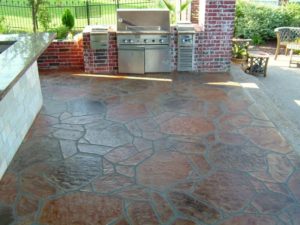
We service all of New Hampshire (NH) , Massachusetts (MA) , and Maine (ME) with Decorative Concrete, Stamped Concrete, Epoxy Floor Coatings, and Garage Flooring. We have a large selection of colors and patterns! Give us a call for your next concrete project. We provide Free Estimates.
Sealing Decorative Concrete
Sealing decorative concrete is an important step in protecting your investment. Sealing helps to prevent staining and fading while also making the surface easier to clean. There are a variety of sealers available, so it’s important to choose the right one for your project. Some sealers are designed specifically for concrete, while others are made for use on other surfaces such as stone or tile.
Sealing Colored Textured Concrete Can Help Keep It Looking New
Concrete is a durable material, but it can still become stained and faded over time. Sealing concrete can help keep it looking new by protecting it from the elements and staining. Sealers come in both water-based and solvent-based varieties, and each has its own benefits and drawbacks. Some sealers are designed to penetrate the surface of the concrete, while others form a protective barrier on top.
The best time to seal decorative cement is soon after it has been installed. This will help prevent any staining or fading that may occur over time. It is also important to reseal decorative concrete every few years to maintain its appearance.
Sealing Decorative Concrete Helps Protect Against Stains and Damage
Sealing concrete is important for protecting it against damage and staining. Sealing helps to fill in any pores or cracks in the surface of the concrete, making it less likely for dirt, oil, or other liquids to seep in and cause a stain. It also helps to protect the concrete from damage caused by weathering or exposure to salt and other chemicals. Sealing decorative concrete is a quick and easy process that can be done by either the homeowner or a professional contractor.
Sealing Textured Concrete Will Help Prevent Mold and Mildew
Mold and mildew are fungi that can grow on any surface, including concrete. Left untreated, they can cause staining and damage to the concrete. Sealing colored concrete will help to prevent mold and mildew from growing by creating a barrier that moisture cannot penetrate. Sealing also makes it easier to clean the surface of any mold or mildew that does form.
How to Choose the Right Sealant for Decorative Surfaces
If you are considering sealing textured concrete, the most important factor to consider is the sealant itself. Not all sealants are created equal, and using the wrong type can cause problems like staining, discoloration, and even a reduced lifespan for your concrete. Here are a few tips on how to choose the right sealant for your needs:
1. Consider the climate. If you live in a colder climate, look for a sealant that is cold-weather resistant. If you live in a hot climate, look for one that is heat resistant.
2. Consider the color of your concrete. Some sealants can cause discoloration over time, so it’s important to choose one that will match the color of your concrete.
3. Consider how much traffic the surface will see.
The Benefits of Sealing Decorative Finishes
Sealing decorative finishes is one of the most important things you can do to protect them. Sealing helps prevent staining and fading, and it also makes the surface easier to clean. In addition, sealers create a barrier that helps protect the concrete from weathering and UV damage.
How to Seal Decorative Cement Yourself
Concrete can be a beautiful addition to your home, but it needs to be properly sealed in order to protect it from the elements. Sealing your concrete is a process that can be done yourself with a few simple tools and supplies.
The first step is to clean the concrete surface. You can use a pressure washer or a garden hose with a scrub brush to remove any dirt or debris. Once the surface is clean, you can begin applying the sealant.
There are many different types of sealants available, so be sure to select one that is specifically designed for concrete. Apply the sealant in a thin coat using a brush, roller, or sprayer. Be sure to cover all of the surfaces evenly and allow the sealant to dry completely before continuing.
Repeat this process every few years to keep your concrete looking beautiful and protected from the elements.
Materials Needed to Seal Concrete Finishes:
Sealing concrete is a necessary step in order to protect it from the elements and extend its life. In order to seal concrete, you will need some basic materials:
-Concrete sealer
-Paintbrush or roller
-Brush for applying the sealant around the edges
-Protective gear, including goggles, gloves, and a mask
When choosing a sealer, be sure to read the label carefully to make sure it is appropriate for use on concrete. Many sealers are designed for use on other types of surfaces, such as wood or stone, so it’s important to choose the right one. Apply the sealant using a brush or roller, making sure to get into all the nooks and crannies. Be sure to wear protective gear while doing this, as the fumes can be harmful.
- How Do You Seal Decorative Concrete
- How Often Do You Have To Reseal Stamped Concrete
- Best Sealer For Stamped Concrete
Our Locations:
Nashua, NH
North Hampton, NH
Concord, NH
